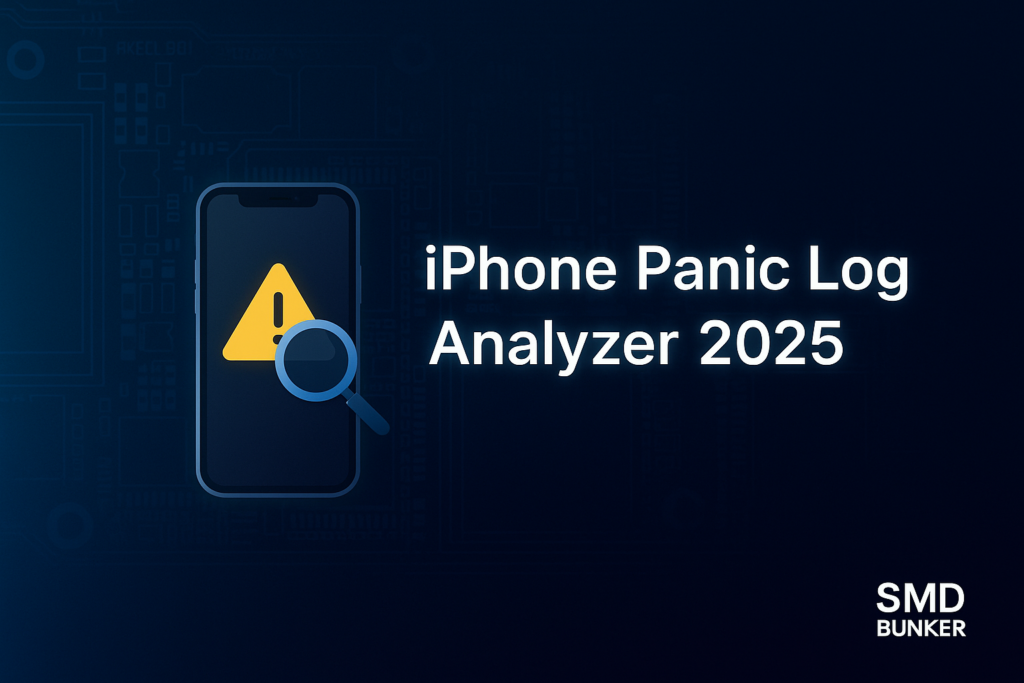Posted on: April 27, 2025 | By SMD Bunker Team

When an iPhone experiences a sudden restart, shutdown, or boot loop, it often generates a “Panic Log.” These logs are a goldmine for technicians and engineers trying to diagnose hardware or software issues. In 2025, analyzing iPhone panic logs has become even more critical, especially with newer A-series chips and updated iOS versions.
At SMD Bunker, we aim to simplify complex repair concepts. Today, let’s dive into how to properly read and analyze an iPhone panic log in 2025.
What is a Panic Log?
A Panic Log is a system-level report generated when the iPhone detects a critical failure. These logs are saved inside the device under:
Settings ➔ Privacy & Security ➔ Analytics & Improvements ➔ Analytics Data
Look for files starting with “panic-full” or “panic”.
Why Analyzing Panic Logs is Important in 2025
- Complex Hardware: With Apple’s newer chips (A16, A17, M1, M2), failures can happen at extremely deep levels.
- Software Complexity: iOS 18 introduced more security and background processes, making it vital to separate hardware issues from software-related panics.
- Precision Repairing: Correctly analyzing panic logs saves time, reduces part swapping, and improves first-time repair success rates.
Key Parts of a Panic Log (2025 Edition)
Here are the main sections you need to focus on:
- Timestamp: When the crash occurred.
- Reason: Provides clues (e.g.,
cpu0 no successful checkins,i2c0 hang detected,watchdog timeout, etc.) - Affected Components: Mentions modules like
i2c0,i2c1,thermalmon,SEP, etc. - Stackshot: Captures what the device was doing when the crash happened.
Common Panic Log Reasons and Solutions (2025)
| Panic Reason | Possible Cause | Solution |
|---|---|---|
i2c0 hang detected | Communication error between CPU and peripheral ICs | Check PMIC, NAND, RAM soldering |
cpu0 no successful checkins | CPU or power issue | Check VDD_MAIN, CPU rails, replace CPU if needed |
thermalmon crash | Overheating or bad thermal sensors | Replace thermal IC or rework logic board |
watchdog timeout | Software freeze or hardware lock | Reflash iOS, if persists, check NAND/PMIC |
📌 Tip: Always cross-reference the panic logs with the iPhone model and SoC generation (A11, A12, A15, etc.) because some components are model-specific!
New Tools and Techniques in 2025

- Automated Panic Log Readers: Apps and tools that read the panic log and suggest possible faulty components automatically.
- AI-assisted Diagnosis: Some platforms now use AI to predict the most likely cause based on panic patterns.
- Panic Log Mappers: Community-shared databases to map i2c buses and component relationships.
Common Panics and Solutions
| Panic Error | Effected Circuit |
| AppleHIDTransportProtocol | Display and Related circuit |
| lop rinobuffer | Audio Related |
| CSL AUDIO | Audio Related |
| CAN Snoop | Power Supply Lines |
Mastering Panic Log Analysis is crucial in 2025 for any technician serious about iPhone repair. It is no longer enough to guess — data-driven diagnosis is the future!
At SMD Bunker, we are committed to providing updated tools, guides, and tutorials to help you succeed in your repair journey.
Stay tuned for upcoming posts where we will cover Panic Log Case Studies, Auto-Panic Decoding Tools, and Hands-on Troubleshooting Techniques.
📢 Have a panic log you want help with?
Post it in our community forum or tag us with #SMDBunkerPanicHelp!
